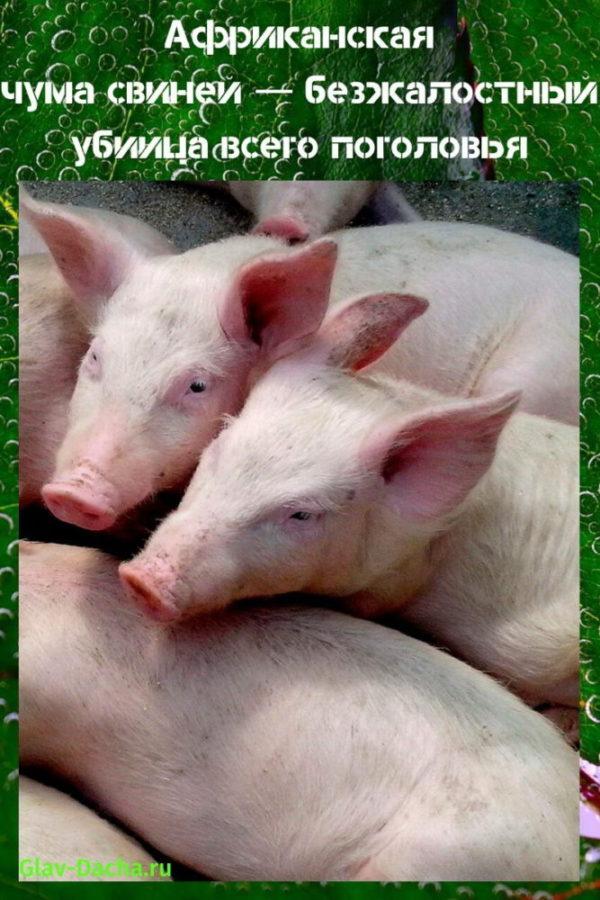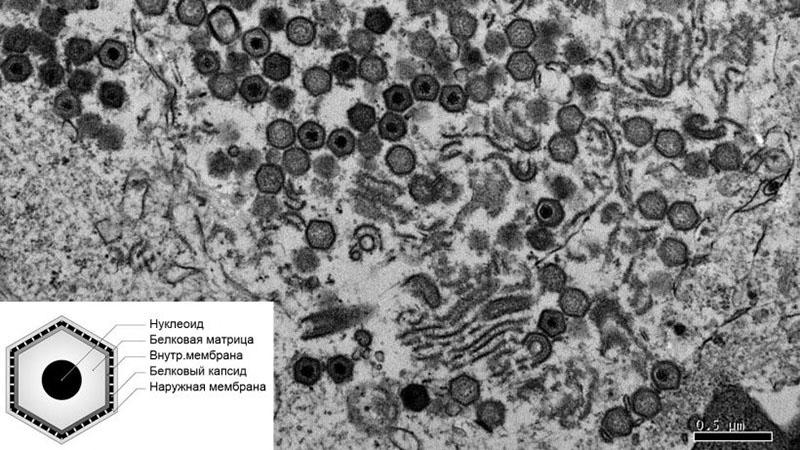African swine fever is the ruthless killer of all livestock
 African swine fever is a particularly dangerous viral disease. A characteristic feature of an infectious disease is its high contagiousness (infectivity), as well as an acute course. The virus is spreading with lightning speed among domestic animals. Often, it is ASF that causes the death of an entire livestock.
African swine fever is a particularly dangerous viral disease. A characteristic feature of an infectious disease is its high contagiousness (infectivity), as well as an acute course. The virus is spreading with lightning speed among domestic animals. Often, it is ASF that causes the death of an entire livestock.
African Swine Fever from a Biological Perspective

The viral breed of the disease has the following features:
- development of inflammatory processes;
- fever;
- cessation of blood supply to internal organs.
African fever is caused by a DNA virus of the iridovirus family. Therefore, in animal corpses, it lasts up to 10 weeks, in meat (even smoked) - 155 days, in manure - 3 months, in soil - six months.
 An autopsy of infected individuals showed what pathological changes the African swine fever virus produces in the animal's body.
An autopsy of infected individuals showed what pathological changes the African swine fever virus produces in the animal's body.
Significant entrained internal organs were found:
- liver;
- spleen (6 times);
- blood vessels;
- kidney;
- lymph nodes.
Large hemorrhages, including massive hematomas, were observed in the muscle tissue. Damage to the lungs (edema), gallbladder (thickening of the walls), kidneys and lymphatic system was recorded. Serous-hemorrhagic fluid was found in the stomach as well as in the respiratory organs.
The symptoms of East African distemper deserve special attention
 The first symptoms of African swine fever appear on days 2-7 or two weeks after infection. The development of the disease depends on the number of existing foci and the speed of their spread.
The first symptoms of African swine fever appear on days 2-7 or two weeks after infection. The development of the disease depends on the number of existing foci and the speed of their spread.
In the acute form of a viral infection in pigs, there is:
- temperature rise up to 40-42˚С;
- shortness of breath, shortness of breath as with pneumonia;
- lethargy and weakness;
- the appearance of blood spots (hematomas) on the skin of the ears, neck, groin and abdomen;

- hind limb paralysis or convulsions (in some individuals);
- upset gastrointestinal tract: vomiting, constipation, or diarrhea with blood clots;
- conjunctival mucosa (white pus with a pungent odor).

Distinguishing ASF from classic plague is difficult. Only a specialist can diagnose a viral infection using laboratory tests.
The acute form of Montgomery's disease lasts up to 7 days. As it progresses, body temperature drops. Then a coma sets in, which is fatal. However, such a manifestation is rare. In other forms, the same symptoms of African fever are observed, only with a duration of up to 20 days. The chronic course is up to several months.
In this case, the condition of the pigs worsens:
- the temperature is kept within 40.5-42˚С;
- individuals lose weight with a relatively good appetite;
- growth slows down;
- necrosis appears on the head and in the abdominal region;
- there are signs of pneumonia / bronchitis;
- limbs are bent by arthritis.
 In African countries, as well as in the Iberian Peninsula, there have been cases of asymptomatic ASF. So, infected individuals infected the whole livestock, which eventually died.As the studies have shown, virus carriers emitted dangerous pathogens in stressful situations.
In African countries, as well as in the Iberian Peninsula, there have been cases of asymptomatic ASF. So, infected individuals infected the whole livestock, which eventually died.As the studies have shown, virus carriers emitted dangerous pathogens in stressful situations.
ASF transmission methods
 Knowing how African swine fever is transmitted will help prevent the spread of the virus. As already mentioned, infected animals are the main source of infection.
Knowing how African swine fever is transmitted will help prevent the spread of the virus. As already mentioned, infected animals are the main source of infection.
At the same time, virus carriers are often:
- people;
- rodents;
- birds;
- domestic or wild animals;
- insects (ticks, flies, lice).

The transmission of a viral infection occurs through close contact. Pathogens enter a healthy body through the mucous membrane (eyes, oral cavity) and skin. They can be found in inventory that is used for slaughter, or in food waste. Infection usually occurs during transport of pigs.
Therefore, when the first signs of an illness appear (blood flows on the body), it is necessary:
- isolate the individual from the herd;
- call a veterinarian;
- examine all livestock;
- wait for the incubation period (15 days).
Regardless of the age, breed and physical condition of animals, the virus infects everyone without exception. Pregnant infected females often miscarry.
 With the help of biological samples, foci of the pathogen are determined. After that, the results from the laboratory are awaited. When this happens, many people wonder what African swine fever is for humans. In fact, an infectious disease does not pose any danger to humans. The virus dies at a temperature of 70-80˚С. However, due to constant mutations of non-cellular agents, the situation can change dramatically.
With the help of biological samples, foci of the pathogen are determined. After that, the results from the laboratory are awaited. When this happens, many people wonder what African swine fever is for humans. In fact, an infectious disease does not pose any danger to humans. The virus dies at a temperature of 70-80˚С. However, due to constant mutations of non-cellular agents, the situation can change dramatically.
Fighting an invisible enemy
 If ASF is diagnosed, the entire herd is completely destroyed. If this is not done, then through insects or other means, the infection will quickly spread throughout the region, leading to an outbreak of the epidemic.
If ASF is diagnosed, the entire herd is completely destroyed. If this is not done, then through insects or other means, the infection will quickly spread throughout the region, leading to an outbreak of the epidemic.
In view of this, individuals in the focus of infection are killed by a bloodless method. Also subject to disposal:
- infected / killed corpses;
- manure;
- food in contact with animals;
- container / inventory;
- wood floors;
- feeders;
- partitions.
In the area of the outbreak, a quarantine is announced, which can last from 40 days to 6 months. Pigs are cleaned up within a radius of 5-20 km from the outbreak of viral infection.
 Everything infected is completely burned. The remains that cannot be burned are buried in trenches at a depth of 2 m, but not less. If it is impossible to eliminate the infected livestock by fire, bury it in the ground.
Everything infected is completely burned. The remains that cannot be burned are buried in trenches at a depth of 2 m, but not less. If it is impossible to eliminate the infected livestock by fire, bury it in the ground.
Be sure to disinfect the premises after:
- destruction of the herd;
- dismantling the premises;
- mechanical cleaning.
Montgomery disease cannot be treated. Until now, scientists have not found a vaccine for the virus, as it constantly mutates.
 As a disinfectant, powerful solutions are used based on formalin (1.5%), vapor form (1.5%), parasod (3%) and chloramine (5%). It is imperative that this composition contains calcium hypochlorite solutions: DSGK and NGK. In addition, dry bleach (25% active chlorine) is sprinkled on all surfaces and the area is thoroughly watered. It is allowed to breed animals of other species in disinfected premises. For example, birds are placed there, but only after 1 year, after the quarantine has been lifted.
As a disinfectant, powerful solutions are used based on formalin (1.5%), vapor form (1.5%), parasod (3%) and chloramine (5%). It is imperative that this composition contains calcium hypochlorite solutions: DSGK and NGK. In addition, dry bleach (25% active chlorine) is sprinkled on all surfaces and the area is thoroughly watered. It is allowed to breed animals of other species in disinfected premises. For example, birds are placed there, but only after 1 year, after the quarantine has been lifted.
For processing, a hot sodium solution (3%) is used, as well as a 2% formaldehyde solution.
Precautions
 The goal of every farmer is to prevent the African plague pathogen from entering the pig farm. Therefore, you should avoid buying animals smuggled into the country.
The goal of every farmer is to prevent the African plague pathogen from entering the pig farm. Therefore, you should avoid buying animals smuggled into the country.
You can minimize the risk of infection with East African plague if:
- limit free range of livestock;
- regularly carry out sanitary disinfection of the pig farm, as well as storage facilities;

- to fight rodents;
- vaccinate against classical plague;

- systematically organize a veterinarian examination of the herd.
In Europe, outbreaks of African fever occur most often in winter or spring. Thus, you need to be especially careful during these periods of the year.
The farm must have a system for waste disposal (decontamination) and pig carcasses. All equipment must be disinfected before use. Most types of feed are heat treated at 80˚C. In addition, solid fences provide suitable protection against contamination. When transporting animals, the body must be treated with antiseptic compounds. 
Contact with herds of neighboring farms is strictly prohibited. This category also includes other pets, birds and even insects.
It is possible to protect the herd from African swine fever. To do this, purchase only those animals that have passed inspection by the State Veterinary Service. Newly arrived individuals are recommended to be quarantined for 7 days. If a viral infection is suspected, they are immediately reported to the sanitary and epidemiological station. Considering all this, the farm will not incur large losses.